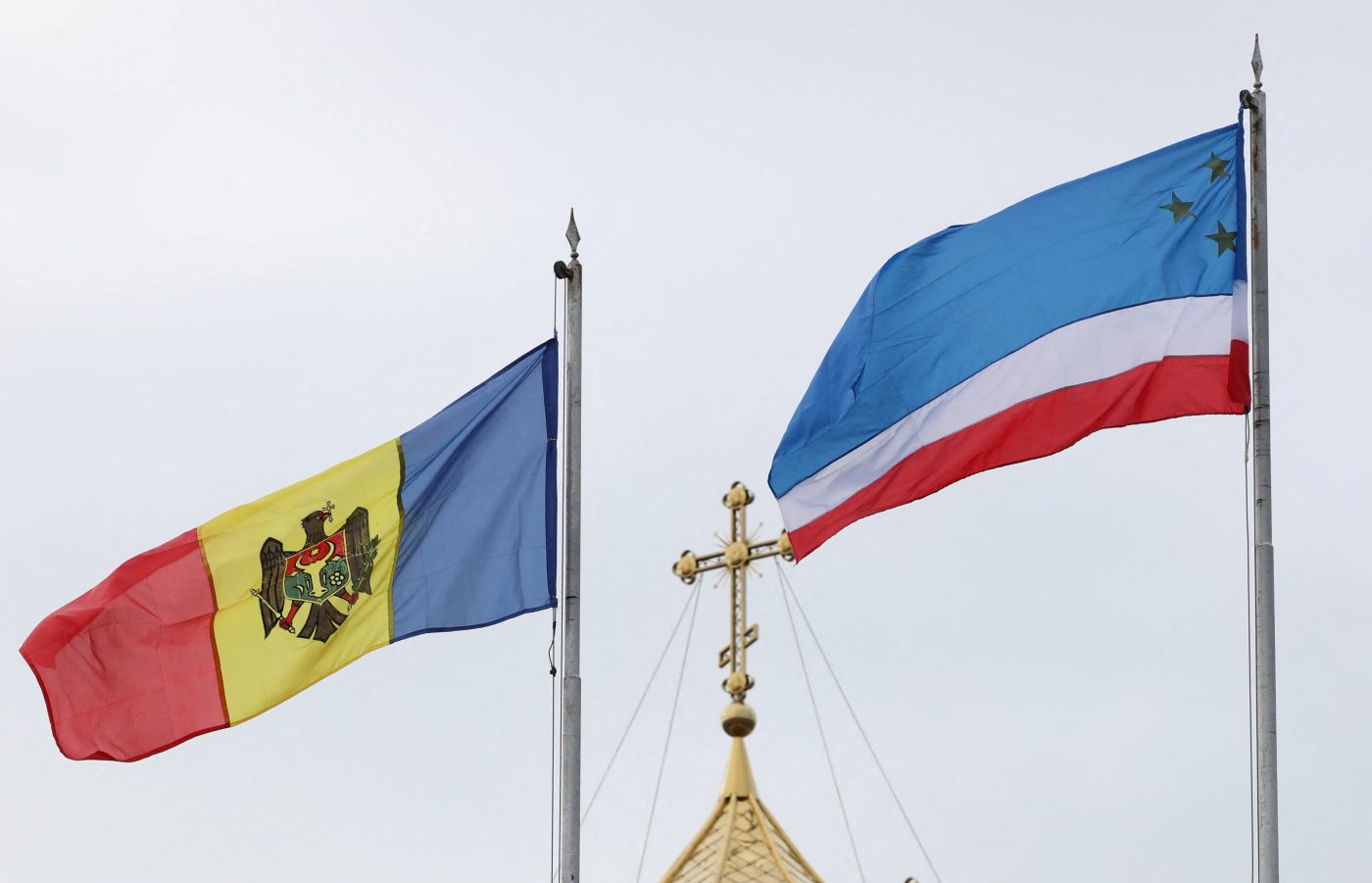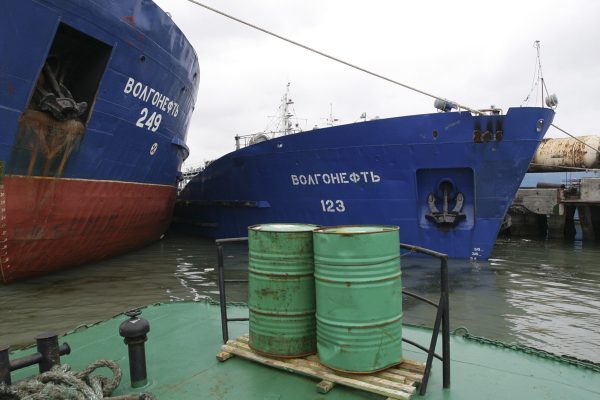A Russian bank, Promsvyazbank, is to start paying money to thousands of residents of Gagauzia, an autonomous region in Moldova. The bank is effectively an arm of the defense ministry — and therefore the Kremlin — and is run by the son of a former senior Russian spy. It is sanctioned in the West.
Gagauzia is carefully chosen. It is in the south of Moldova and has a history of separatist sentiment. The Kremlin might well be hoping to stoke that (just as its spies have fueled unrest in the country as a whole) and so cause headaches for the pro-Western Moldovan government as the country approaches presidential elections by December.
There is nothing covert about this. Russia is acting in the open. Evghenia Gutul, the pro-Kremlin governor of Gagauzia, signed an agreement during her visit to Moscow, which stipulates that all pensioners and public sector employees in the region can apply for a monthly payment equivalent to $100 (in a country where the average pension is $220.)
According to the plan, 25,000 out of Gagauzia’s 120,000 residents, who are mostly Orthodox Gagauz, a Turkic ethnic group, are eligible. The annual bill for the Russians would be about $30m.
They don’t need to go to Russia for that; they can apply remotely. To receive regular payments, Gagauz residents are offered so-called Mir cards issued by Promsvyazbank. The state-owned lender also operates in four illegally annexed Ukrainian regions. The agreement with Gutul was signed by Petr Fradkov, the bank’s chairman, and a son of a former director of the Russian foreign intelligence agency, the SVR.
Fradkov said that the agreement provides for cross-border payments, which is possible thanks to Mir — the Russian national payment system.
Mir was launched in 2016 but had little success until the imposition of Western sanctions on the Russian financial sector, including the withdrawal of Visa and Mastercard, and finally the SWIFT payments system.
For Russians, the Kremlin made Mir the default choice; for those who had left, Mir gradually became the only option to transfer money from Russia, and — for those hundreds of thousands working abroad — to get paid.
Russian banks, feeling the increasing demand, stepped up efforts to make Mir available abroad — starting with the illegally occupied Georgian region of Abkhazia, then expanding to Central Asia and Belarus, Turkey, Venezuela, and Cuba. By mid-2023 Russia was also negotiating about Mir with Iran, India, Egypt, Indonesia, and others.
The US targeted Mir in February when the US Treasury Department’s Office of Foreign Assets Control (OFAC) sanctioned Mir’s operator. The measures could make it impossible to use its cards to withdraw cash from ATMs in some countries, but not everywhere, and not immediately.
(This will inflict collateral damage on many Russian exiles who have nothing to do with the Kremlin’s subversive operations but can only find work with Russian-based companies since they are not particularly welcome to work in Europe.)
The Moldovan initiative is a shining example of Russia’s opportunist approach and of the deep influence of intelligence agencies in its foreign policy.
Mir has prospered because it is unplugged from the international financial system, and yet that makes it perfect for subversive operations. This operation in a little-known area may also be a trial for similar operations elsewhere. In theory, nothing can stop the Kremlin from issuing Mir cards remotely to pro-Kremlin communities in other countries — the substantial Russian communities in two of the Baltic states, for example.
This type of thinking dates to the Soviet era, when the Kremlin would seek to turn handicaps to its own advantage.
The Soviet Politburo had at its disposal a large network of state-owned banks abroad (called sovzagranbanki – Soviet foreign banks) from London to Singapore, and Tehran to Paris to Zurich. Their mission was to help the Soviets buy, sell, and borrow in Western hard currencies. Some of the banks were launched in the 1920s; others during the Cold War.
In the mid-1960s, the Kremlin required those banks to transact in a way that was untraceable for the United States.
This was prompted by a 1959 lawsuit. A Russian émigré in the United States sued the Soviet Union in a New York court, accusing Soviet authorities of failing to make payments on their obligations to two English corporations with concessions in the Soviet Union. A lawsuit was brought against Chase Manhattan Bank for transferring money from the accounts of Soviet banks at Chase.
That made Soviet bankers very jumpy — what if the Americans blocked all their accounts in Western banks? As a result, they moved their dollar accounts to Soviet banks abroad. That was how a closed system of the new currency emerged, which became known as Eurodollars — completely untraceable for the Americans.The goal, a high-ranking Russian banker explained to these authors several years ago, was “to make Soviet dollar transactions impenetrable for the US government.”
Those banks also sold Soviet gold, another untraceable commodity. The Wozchod Bank in Switzerland, for instance, had a monopoly selling Soviet gold from 1972. It worked like this: Soviet gold was transported to Zurich by ordinary Soviet passenger aircraft carrying seven tons of gold per flight.
Standard ingots of 12.5kg (28lbs) were distributed evenly throughout the plane under the passenger seats — because the gold was heavy, the weight had to be evenly distributed to protect the aircraft’s flight characteristics. The ingots were then transferred to Wozchod and sent to the partners’ smelting and refining factories, where the hammer and sickle stamped onto the ingots were erased.
Gold and eurodollars were used for legitimate Soviet financial transactions, but also to provide untraceable funds to foreign Communist parties and so-called liberation movements in the developing world. The payments were essentially Soviet-funded subversion activities.
Wozchod Bank survived the collapse of the Soviet Union — these days it is Gazprom bank in Zurich. The lender was found to have been engaged in the money laundering of Vladimir Putin’s personal wealth by a Swiss court last year.
Wherever there’s a weakness in the Western financial system, Russia’s extensive and experienced espionage network will find it. Indifferent to the costs — it is awash with cash — it will find the point of least resistance, and use it.
Democracies need to get much better at tracing the tendrils of the Kremlin’s covert financial network, take a large pair of regulatory shears, and cut them down.
Irina Borogan and Andrei Soldatov are Non-resident Senior Fellows with the Center for European Policy Analysis (CEPA.) They are Russian investigative journalists, and co-founders of Agentura.ru, a watchdog of Russian secret service activities.
Europe’s Edge is CEPA’s online journal covering critical topics on the foreign policy docket across Europe and North America. All opinions are those of the author and do not necessarily represent the position or views of the institutions they represent or the Center for European Policy Analysis.





